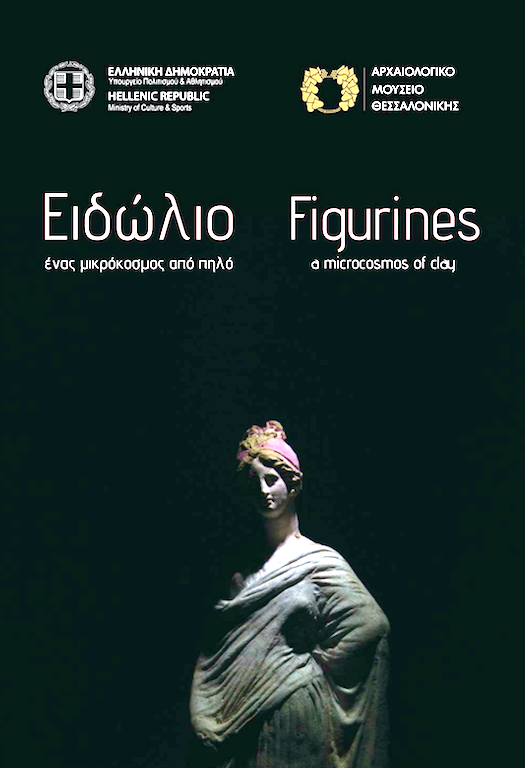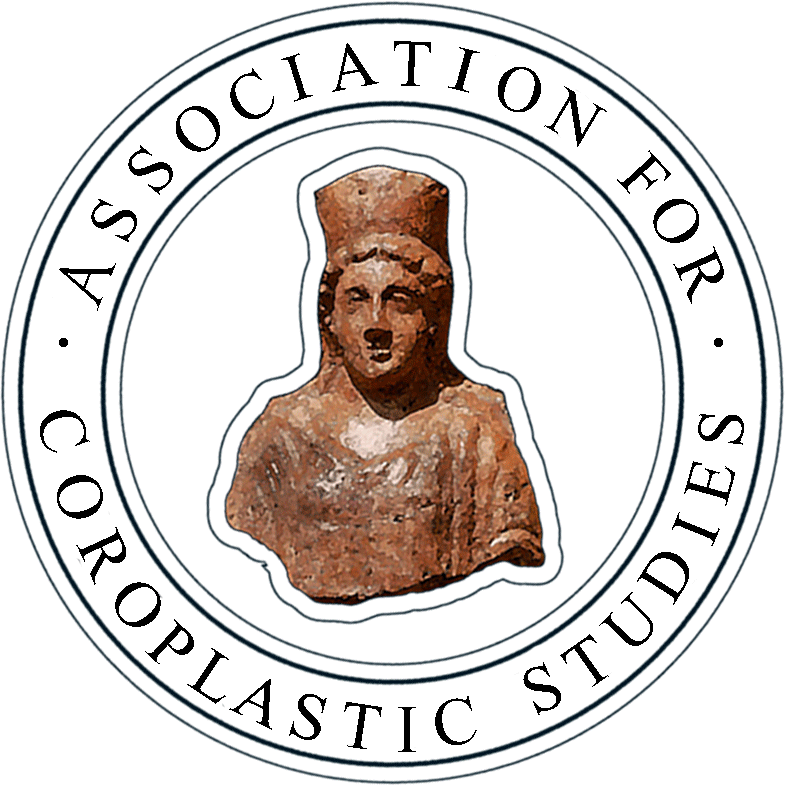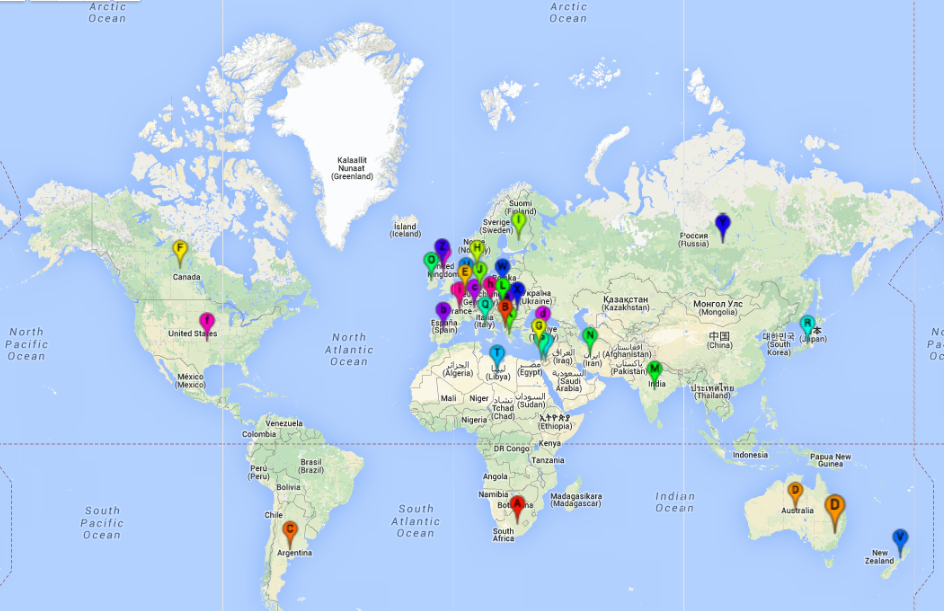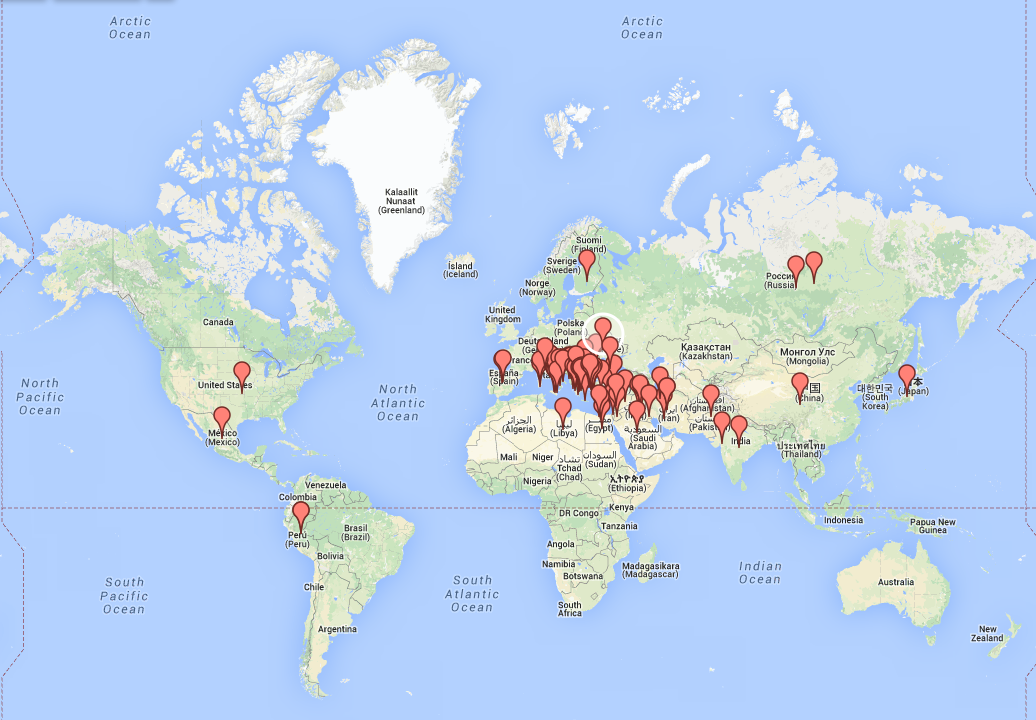- March 2017
- September 2017
- Décembre 2017
- January 2018
- Mai 2018
- Décembre 2018
- Mars 2019
- Mars 2020
- Mars 2021
- Juin 2022
- This is a call for submissions for the next issue of Les Carnets de l'ACoSt which will appear in Spring 2017.
- This open access journal incorporates the former ACoSt Newsletter, which is no longer published as an independent entity, but which is incorporated into Les Carnets. Les Carnets also features longer, in-depth articles on coroplastic topics that are subjected to anonymous peer review. Communications submissions should be no more than two pages, not including illustrations and references, while presently there is no limit on the length of submitted articles. Submissions can be in English, French, Italian, German, or Spanish.
- Les Carnets is published through revues.org, a French center for open electronic publishing.
- The deadline for submissions is March 15, 2017.
- Please send submissions to the Editorial Secretary (acost@univ-lille3.fr). Submissions must be in a doc. or docx. format and images (.jpg) must be submitted as individual files.
- Please do not send a pdf, unless it is for clarification.
- References and bibliography follow the style guidelines of the American Journal of Archaeology (http://www.ajaonline.org/pdfs/AJAInstructions.pdf).
Terracottas in the Mediterranean Through Time II
March 12–15, 2018
University of Haifa, Israel
The Zinman Institute of Archaeology, the Department of Art History, and the Department of Archaeology of the University of Haifa invites the submission of papers for the conference "Terracottas in the Mediterranean Through Time II" dedicated to the study of terracotta figurines and related objects in the Mediterranean region from the early periods to late antiquity. The first Haifa conference to focus on coroplastic topics was held from March 23 to March 25, 2015.
“Terracottas in the Mediterranean Through Time II” will take place at the University of Haifa in Israel from March 12 to March 15, 2018, and will include fieldtrips. The conference is held under the auspices of the Association for Coroplastic Studies (ACoSt).
The conference aims to bring together scholars and students who often tackle the same issues as they study clay figurines and related objects from different periods and parts of the Mediterranean region. Scholars who research terracottas of illiterate societies often use anthropological and ethnographical methods, while those studying terracottas of historical periods refer to historical sources and artistic analogies. The various viewpoints and attitudes may enrich and deepen our understanding of terracotta figurines and their role in society.
The scope of issues to be discussed at the conference will be wide and will follow the different stages of the terracottas' lives:
First stage – the artisans or coroplasts: aspects of manufacture; typology and iconography; production of large- and small-scale terracottas; organization of workshops; questions of specialization; new technologies employed in identifying workshops.
Second stage – patterns of distribution: interaction between production centers and markets; trade; imitations.
Third stage – the users: Who used terracottas and who did not; how they were used; usage through space and time; themes and types in specific contexts (sacred, funereal and domestic); choice of types; symbolic meaning conveyed by terracottas; terracottas and gender.
Fourth stage – phasing out: How, why and when terracottas went out of use; patterns of deposition or obliteration; archaeological context of terracottas and its meaning.
A special issue to be discussed in the conference is: Zooming out: terracottas along with… We would like to address terracottas not just as a separate category, but to examine what accompanies them in different contexts, and how did terracottas act beside other objects and materials in all four categories mentioned above. This viewpoint may provide a better understanding of the role terracottas played in ancient societies.
The official language of the conference is English. Presentations should not exceed 20 minutes. We invite proposals for panels and individual papers on these and related topics.
Abstracts of 200–300 words should be submitted by 30 September 2017 to Dr. Adi Erlich, aerlich@research.haifa.ac.il in Word format including surname, first name, position, affiliation, phone number, email address and title of paper.
The organizers, Dr. Adi Erlich and Dr. Sonia Klinger
Deadline for submissions December 1, 2017
Call for Papers: Terracottas in the Mediterranean Through Time II — 12-15 March 2018, University of Haifa, Israel
The Zinman Institute of Archaeology, the Department of Art History and the Department of Archaeology of the University of Haifa, invites the submission of papers for the second conference "Terracottas in the Mediterranean Through Time II," dedicated to the study of terracotta figurines and related objects in the Mediterranean region from the early periods to late antiquity. The first conference of the same name was held in March 2015.
The conference will take place at the University of Haifa in Israel from 12-15 March 2018, and will include fieldtrips. It is being held under the joint auspices of the Association for Coroplastic Studies (ACoST) and the The Zinman Institute of Archaeology, the Department of Art History and the Department of Archaeology of the University of Haifa.
The conference aims to bring together scholars and students who often tackle the same issues as they study clay figurines and related objects from different periods and parts of the Mediterranean region. Scholars who research terracottas of illiterate societies often use anthropological and ethnographical methods, while those studying terracottas of historical periods refer to historical sources and artistic analogies. The various viewpoints and attitudes may enrich and deepen our understanding of terracotta figurines and their role in society.
The scope of issues to be discussed at the conference will be wide, and will follow the different stages of the terracottas' lives:
First stage – the artisans or coroplasts: aspects of manufacture; typology and iconography; production of large- and small-scale terracottas; organization of workshops; questions of specialization; new technologies employed in identifying workshops.
Second stage – patterns of distribution: interaction between production centers and markets; trade; imitations.
Third stage – the users: Who used terracottas and who did not; how they were used; usage through space and time; themes and types in specific contexts (sacred, funereal and domestic); choice of types; symbolic meaning conveyed by terracottas; terracottas and gender.
Fourth stage – phasing out: How, why and when terracottas went out of use; patterns of deposition or obliteration; archaeological context of terracottas and its meaning.
Special issue to be discussed in the conference is: Zooming out: terracottas along with… We would like to address terracottas not just as a separate category, but to examine what accompanies them in different contexts, and how did terracottas act beside other objects and materials in all four categories mentioned above. This viewpoint may provide a better understanding of the role terracottas played in ancient societies.
The official language of the conference is English. Presentations should not exceed 20 minutes. We invite proposals for panels and individual papers on these and related topics.
Abstracts of 200–300 words should be submitted by December 1, 2017 to Dr. Adi Erlich, aerlich@research.haifa.ac.il in Word format including surname, first name, position, affiliation, phone number, email address and title of paper.
The organizers, Dr. Adi Erlich and Dr. Sonia Klinger
-------------------------
Deadline for submissions: December 1,2017
Call for paper : Terracottas of the Edible in the Ancient Mediterranean
Panel for the international conference - Terracottas in the Mediterranean Through Time II
March 12-15, 2018, University of Haifa, Israel
Meritxell Ferrer (Postdoctoral Researcher, Departament d’Humanitats, Universitat Pompeu Fabra, Barcelona, Spain) meritxell.ferrer@upf.edu
Mireia López-Bertran (Lecturer, Department of Art History, Universitat de València, València, Spain) mireia.lopez@uv.e
Several studies have revealed that food should not be examined exclusively in connection with the act of meeting a basic biological need for human subsistence. On the contrary, most of these studies have shown that the analysis of food, foodways and food preparation and consumption practices are crucial to understanding the dynamics of ancient societies.Following these studies, this panel we explores clay representations of food in its wider sense. That is, it focuses on terracottas of the edible –such as fruits, animals or bread–, human-like clay figurines undertaking activities related to food preparation, presentation and consumption, as well as clay tools related to food processing, such as clay stamps.We invite papers that present materials from diverse contexts (domestic, sacred and funerary) and different chronologies. We encourage a focus on connections with other materials from the same context to propose interpretative links between terracottas and other types of material culture –such as cooking and serving vessels or seed and animal remains– in order to analyse the relationship between “real” and “imagined” food, taking into consideration a critical approach to this division.We are also interested in engendering both the space and the use of terracottas. Food processing is mostly considered to be a female activity where children could offer assistance. When we consider practices such as the votive offering of figurines of the edible, however, the gender issue seems to be broader. Other topics to be considered are the size of the food represented in terracottas –such as fruits or loaves of bread– in relation to real food; the possibility of distinguishing patterns in the kind of food represented across time and culture; and the relationship between food representations and the identity of those who owned and produced these objects.
- This open access journal incorporates the former ACoSt Newsletter, which is no longer published as an independent entity, but which is incorporated into Les Carnets. Les Carnets also features longer, in-depth articles on coroplastic topics that are subjected to anonymous peer review. Communications submissions should be no more than two pages, not including illustrations and references, while presently there is no limit on the length of submitted articles. Submissions can be in English, French, Italian, German, or Spanish.
- Les Carnets is published through revues.org, a French center for open electronic publishing.
- The deadline for submissions is January 15, 2018.
- Please send submissions to the Editorial Secretary (acost@univ-lille3.fr).
- Submissions must be in a doc. format and images (.jpg, 300Dpi) must be submitted as individual files.
- Please do not send a pdf, unless it is for clarification.
- References and bibliography follow the style guidelines of the American Journal of Archaeology (http://www.ajaonline.org/pdfs/AJAInstructions.pdf).
This is a call for submissions for the next issue of Les Carnets de l'ACoSt which will appear in Winter 2018.
- This open access journal incorporates the former ACoSt Newsletter, which is no longer published as an independent entity, but which is incorporated into Les Carnets. Les Carnets also features longer, in-depth articles on coroplastic topics that are subjected to anonymous peer review. Communications submissions should be no more than two pages, not including illustrations and references, while presently there is no limit on the length of submitted articles. Submissions can be in English, French, Italian, German, or Spanish.
- Les Carnets is published through revues.org, a French center for open electronic publishing.
- The deadline for submissions is July 15, 2018.
- Please send submissions to the Editorial Secretary (acost@univ-lille3.fr).
- Submissions must be in a doc. format and images (.jpg, 300Dpi) must be submitted as individual files.
- Please do not send a pdf, unless it is for clarification.
- References and bibliography follow the style guidelines of the American Journal of Archaeology (http://www.ajaonline.org/pdfs/AJAInstructions.pdf).
Call for Papers => Submission deadline: December 1, 2018
“When the clay is under the fingernail”[1] Modelling in the Ancient Greek World
International Colloquium, April 3-5, 2019
Centre Camille Jullian, Aix-Marseille University, Marseille
Hélène Aurigny (Aix-Marseille University, Centre Camille Jullian)
Laura Rohaut (UPV Montpellier 3, LabEx Archimède)
The « Centre Camille Jullian » is organizing an international colloquium on the hand-modelling of clay figurines in the ancient Greek world. Scheduled for April 3-5, 2019, this colloquium will take place at the Maison Méditerranéenne des Sciences de l’Homme, 5 rue du Château de l’Horloge, 13090 Aix-en-Provence, France. https://www.mmsh.univ-aix.fr/
The preferred languages for the submitted proposals and accepted papers are French and English, and papers should not exceed 25 minutes. We invite submissions on one or more of the themes that are listed at the end of this call. To submit a proposal for a paper please send an abstract of 200 to 300 words to Hélène Aurigny (aurigny@mmsh.univ-aix.fr) and Laura Rohaut (laura.rohaut@univ-montp3.fr) as a Word document that include you full name, title, affiliation (if any), and email address.
Accommodation and meal expenses in Aix during the colloquium will be covered by the Colloquium, but participants must pay their own travel expenses. Final participants will be notified in January 2019.
Call for Papers : in english — in french
Orientation of the Colloquium
Moulding techniques and their consequences on the organization of systems of production for Greek figurative terracottas, among other artefacts, have been the object of study for the last 70 years or so. But rarely are systematic coroplastic analyses focused on hand modelling. While modelled artefacts often have been examined within the context of larger coroplastic corpora, these artefacts appear to have been dismissed as unworthy of further comment in most of these corpora. The hand modelling of figurative terracottas has been associated predominately with the Archaic period, but this technique does not disappear entirely with the introduction and widespread use of the mould.
Modelling, the basic technical stage?
This relative lack of visibility in the bibliography for coroplastic studies is not unrelated to the status of hand-made figurines, compared to their mould-made counterparts, since they are often considered as belonging to a less advanced stage of production before the invention of the mould and its complex techniques. However, we can assert that modelling did not disappear when moulding techniques became common, and that hand-made figurines still existed in the Hellenistic and Roman Imperial periods.
The manipulation of clay by hand for image making is a technique that is so ancient that it appears in the creation mythology of a number of civilizations. The first man was created from clay, according to the Bible, and Pausanias (10, 4, 4) tells us that Prometheus modelled the first man from clay. In all these traditions the divine modellers can be considered the first coroplasts.
Hand modelling was the first step in the process of creation for moulded figurines, since it was used to manipulate and form a clay image, or prototype, from which one or several moulds were made for mass production. It is important to keep in mind that hand modelled figurines also could be mass produced, not only in the Archaic period, but, as is demonstrated by several sets of Classical and Hellenistic figurines, could be manufactured in large quantities for votive uses in later Greek contexts.
Techniques of modelling and objects
Hand modelling in clay is a simple technique. But this seeming simplicity also tends to obscure the countless possibilities for experimentation and combination with other techniques. Thus, modelling is used in combination with moulding to make figurines for which only the head is mould made; modelling can also be used in combination with wheel-made elements. It is this wide range of possibilities that this colloquium aims to explore.
A broad Mediterranean perspective
The focus is of this colloquium is on hand-modelled Greek figurines, reliefs, ceramics with hand-modelled decoration, architectural models, or even large clay statues, in order to explore their inherent technical characteristics. The study of modelling in the ancient Greek world can best be viewed within a broad geographical framework such as is offered by the Mediterranean world. Indeed, the study of regional traditions makes it possible to highlight the persistence and diffusion of certain creative processes within different contexts and to question the notion of style. Nevertheless, hand modelling, which by definition does not belong within a mechanically reproducible system, is a technique that yields products created for local use. One can gain an informative perspective in the understanding of this production and its diffusion on a regional level. Particularly interesting are examples from the eastern Mediterranean (Cyprus, Crete, Greek Mainland and the Greek islands), as well as southern Italy and Sicily.
Objectives and limits
Within the limited framework of a three-day colloquium, the goal is not to arrive at a comprehensive overview of hand modelling. While the presentation of corpora of small or poorly-known modelled figurines are welcomed, the objectives of this colloquium are to bring to the forefront an assessment of the methods of analysis of this type of material, for which the standard considerations of series and generations are not always relevant. It will also be an opportunity for a historiographic approach to modelling. In this way it is anticipated that more knowledgeable emphases will be placed on hand-modelled artefacts in the future and that these seemingly simple objects can take a more prominent place in the history of art and archaeology of the Greek world.
Themes
- 1. Literary sources and the vocabulary of modelling. Myths and divinities pertaining to modelling. Iconography of clay modelling.
- 2. Creation of the model, relation to the technique of bronze casting. Workshops, local production and traditions, modelling and styles.
- 3. Techniques, including shaping, aggregate elaboration, surface manipulation, cutting, pinching, rolling, rouletting, inclusion of moulded or wheel-made elements, etc. Produced objects: figurines, reliefs, ceramics with modelled decoration, large clay sculpture, architectural models…
- 4. Dating of modelled figurines; chronological issues. Historiographic approach.
- This open access journal incorporates the former ACoSt Newsletter, which is no longer published as an independent entity, but which is incorporated into Les Carnets. Les Carnets also features longer, in-depth articles on coroplastic topics that are subjected to anonymous peer review. Communications submissions should be no more than two pages, not including illustrations and references, while presently there is no limit on the length of submitted articles. Submissions can be in English, French, Italian, German, or Spanish.
- Les Carnets is published through revues.org, a French center for open electronic publishing.
- The deadline for submissions is March 15, 2019.
- Please send submissions to Christine Aubry (acost@univ-lille3.fr).
- Submissions must be in a doc. or doc. format and images (.jpg, 300dpi) must be submitted as individual files (Editorial Guidelines for authors)
- Please do not send a pdf, unless it is for clarification.
- References and bibliography follow the style guidelines of the American Journal of Archaeology (http://www.ajaonline.org/pdfs/AJAInstructions.pdf).
AIAColloquium on Archaeomusicology:
Soundscapeand Landscapeat Panhellenic Greek Sanctuaries
122th Annual Meeting of the Archaeological Institute of America and the Society for Classical Studies STUDIES
Chicago, IL, January 7-10, 2021
Sponsored by the AIA Archaeomusicology Interest Group
Organizers: Erica Angliker, Institute of Classical Studies. University of London and Angela Bellia, Institute of Heritage Science. National Research Councilof Italy
=> Call for papers
International Conference
What Can Terracottas Tell Us
Coroplastic Polysemy in the Ancient Mediterranean
=> Call for papers
- 2016
- 2018
- 2021
- 2022
- 17-18 novembre 2016, de 9h à 18h — Terres cuites grecques et romaines. 20 ans d’étude et de restauration
Centre de recherche et de restauration des musées de France – amphithéâtre Palissy, Palais du Louvre – Porte des Lions , 14, quai François Mitterrand, 75001 Paris
Comité d’organisation : Violaine Jeammet (musée du Louvre, département des Antiquités grecques, étrusques et romaines)Brigitte Bourgeois, Sandrine Pagès-Camagna, Martin Szewczyk assistés de Fanny Matz (C2RMF).
- A one-day colloquium "Simbolo e gesto: La determinazione di genere nelle statuette fittili del mondo greco" will be held at the Univerisity of Genoa on Tuesday, April 5, 2016. This event will take place in the Aula Magna of the School of Humanistic Sciences, via Balbi 2. Attached is a pdf of the announcement for your examination.
- 11-13 okτωβριου 2018, Αρχαιολογικό Μουσειο Θεσσαλονίκης — Το ειδώλιο στον βορειοελλαδικό χώρο από την προϊστορία έωσ τους ρωμαϊκούς χρόνους
=> program
- 25th February 2021 HERITAGE SCIENCE On Air From the Digitalisation to the Virtual Reconstruction and Sound Simulation of Ancient Musical Instruments: Methods, Results, Perspectives
=> program
=> inscription
- October 20-22, 2022
Terracottas in Motion.
A three-day ZOOM colloquium
=> program
-
 The Archaeological Museum of Thessaloniki
invites you to the opening of the new temporary exhibition
FIGURINES
a microcosmos of clay
on Monday, 3rd April 2017, at 19:00
The Archaeological Museum of Thessaloniki
invites you to the opening of the new temporary exhibition
FIGURINES
a microcosmos of clay
on Monday, 3rd April 2017, at 19:00
- The opening of the exhibition will be held by the Secretary General of the Ministry of Culture and Sports, Mrs. Maria Andreadaki-Vlazaki
- Emergency Red List of Syrian Cultural Objects at Risk
- Following reports of widespread damage and looting at cultural heritage sites in Syria, ICOM decided to publish the Emergency Red List of Syrian Cultural Objects at Risk with the aim to help art and heritage professionals and law enforcement officials identify Syrian objects that are protected by national and international legislations. In order to facilitate identification, the Emergency Red List illustrates the categories or types of cultural items that are most likely to be illegally bought and sold.
 Association for Coroplastic Studies
Association for Coroplastic Studies

